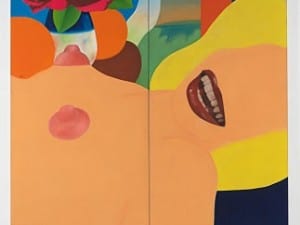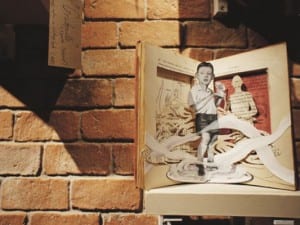Text by Emily Sack
It may seem that a fictional institution created to further the research of a fictional scholar and his fictional endeavours would be too abstract and absurd to have any real artistic clout, but Patrick Keiller’s most recent project brings the imaginary to life in a very real and concrete way. Robinson, the enigmatic scholar, seeks to explain the current economic and social condition based on historical events and their remnant markings on the landscape.
The exhibition in the beautiful and spacious Duveen Galleries of Tate Britain resembles a cabinet of curiousities filled with works from the Tate collection as well as other artifacts and objects spanning diverse concentrations from art to geology in equally diverse media. Patrick Keiller undertook the monumental task of browsing the Tate collection for works to include in The Robinson Institute. These works represent historical prints, drawings, and paintings from JMW Turner and James Ward grouped seamlessly with some of the biggest names in 20th-century art including Joseph Beuys, Eduardo Paolozzi, and Andreas Gursky. The incongruousness of time, media, and styles represented highlight Robinson’s thesis: that events and sentiments in history reoccur throughout time and this results in the present status quo. To Robinson nothing is random; even the falling of a meteor relates to contemporaneous events.
The exhibition begins with a diagram of Robinson’s journey through the English landscape, and this route determines the arrangement and chronology of the exhibition. Visitors are confronted with depictions of travelers and wanderers, as though to legitimise Robinson’s method of research. Robinson relies of textual sources, of course, as any good scholar would (and a number of these are on display), but it is important to note that the most poignant of discoveries are made outside the library, in the environment being studied.
The journey sets about the chart the development of the Industrial Revolution and the rise of capitalism. This begins, in Robinson’s research, with the 1795 Settlement Act that allows rural works to migrate more easily to cities and industrial centres in search for work and a better life. The actual act in scrolling 18th century penmanship has been lent by the Parliamentary Archives and is displayed alongside a larger-than-average meteorite that fell in the same year. The juxtaposition of a large piece of rock from space with the seemingly closer migration of man bridges the phenomenological with the concrete.
Circling around the galleries, the visitor is soon confronted with images of nuclear anxiety. The jump from 1795 to mid-20th century and present day is a bit drastic, but it emphasises a cause and effect relationship. Scientific development has provided civilization with countless advantages over the preceding generations and a greater understanding of the world, but it has also caused terrible destruction and augmented existing conflicts. Science and industry, since the beginning have inspired both awe and fear, but the development of nuclear warfare, postulates Robinson, has encouraged a more pessimistic worldview.
The octagon space of the Duveen Galleries is used to screen an hour of re-edited footage accumulated by Keiller for the 2010 film Robinson in Ruins. The scenes included allow visitors to see the world from Robinson’s point of view, almost as a bird-watcher – patiently observing the landscape and hoping for a revelation. The footage focuses on the natural landscape and highlights Robinson’s belief that history has left physical and tangible markings that help present-day scholars interpret the past. An exhibition text notes that “Robinson inclined to ‘biophilia’, the love of life and living systems, having learnt that symbiotic relationships between organisms are a primary force in evolution.” The faceless scholar sees mankind and its relationship to with time as a “living system” that requires the past to create the future.
The Robinson Institute is certainly interesting as an exhibition and creates a genre of its own. While several of the photographs in the exhibition, as well as the film footage, are shot by Patrick Keiller himself, the majority of the exhibition includes work by other artists, and objects that are not art at all. It becomes apparent that in this case the exhibition becomes single work of art; that all the varied parts create one whole, and this blurs the boundary between artist and curator to an extent.
Simultaneously educational and whimsical, thought provoking and humourous, Patrick Keiller takes visitors on a journey throughout the country and throughout time. Robinson believed that “if he looked at the landscape hard enough, it would reveal to him the ‘molecular basis’ of historical events,” and perhaps if more people took the time to study in this way, there would be a greater understanding of the present world.
Tate Britain Commission 2012: Patrick Keiller, 27/03/2012 – 14/10/2012, Tate Britain, Millbank, London, SW1P 4RG. www.tate.org.uk/britain
Aesthetica in Print
If you only read Aesthetica online, you are missing out. The April/May issue of Aesthetica is out now and includes a diverse range of features from Bauhaus: Art as Life, a comprehensive survey of one of the most influential schools of thought from the 20th century, Growing Up: The Young British Artists at 50, which centres on Jeremy Cooper’s examination of the illustrious career, and the phenomenon that was the YBAs and Behind Closed Doors, an intimate portrait of family life in Cuba from photographer David Creedon.
If you would like to buy this issue, you can find your nearest stockist here. Better yet, subscribe to Aesthetica for a year and save 20% on the printed magazine. To subscribe visit the website or call us on +44 (0) 1904 629 137.
Caption:
Patrick Keiller
Robinson in Ruins (2010)
Film Still
© Patrick Keiller





